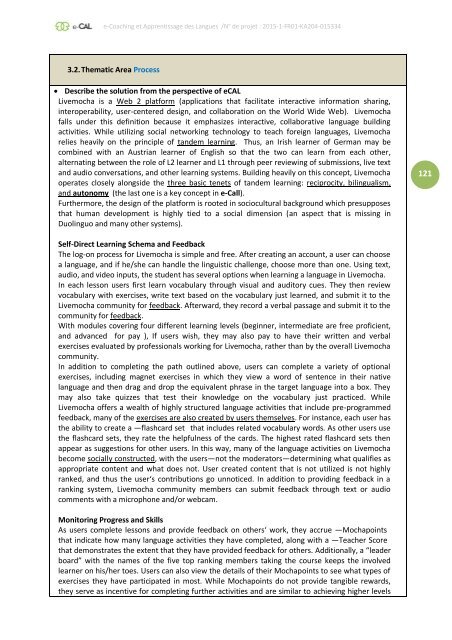e-CAL - e-Coaching et Apprentissage des Langues
The ERASMUS+ project e-CAL presents the result of an analysis of support methods in the case of language learning using web-based Open Educational Resources (OER).
The ERASMUS+ project e-CAL presents the result of an analysis of support methods in the case of language learning using web-based Open Educational Resources (OER).
You also want an ePaper? Increase the reach of your titles
YUMPU automatically turns print PDFs into web optimized ePapers that Google loves.
e-<strong>Coaching</strong> <strong>et</strong> <strong>Apprentissage</strong> <strong>des</strong> <strong>Langues</strong> /N° de proj<strong>et</strong> : 2015-1-FR01-KA204-015334<br />
3.2. Thematic Area Process<br />
Describe the solution from the perspective of e<strong>CAL</strong><br />
Livemocha is a Web 2 platform (applications that facilitate interactive information sharing,<br />
interoperability, user-centered <strong>des</strong>ign, and collaboration on the World Wide Web). Livemocha<br />
falls under this definition because it emphasizes interactive, collaborative language building<br />
activities. While utilizing social n<strong>et</strong>working technology to teach foreign languages, Livemocha<br />
relies heavily on the principle of tandem learning. Thus, an Irish learner of German may be<br />
combined with an Austrian learner of English so that the two can learn from each other,<br />
alternating b<strong>et</strong>ween the role of L2 learner and L1 through peer reviewing of submissions, live text<br />
and audio conversations, and other learning systems. Building heavily on this concept, Livemocha<br />
operates closely alongside the three basic ten<strong>et</strong>s of tandem learning: reciprocity, bilingualism,<br />
and autonomy (the last one is a key concept in e-Call).<br />
Furthermore, the <strong>des</strong>ign of the platform is rooted in sociocultural background which presupposes<br />
that human development is highly tied to a social dimension (an aspect that is missing in<br />
Duolinguo and many other systems).<br />
121<br />
Self-Direct Learning Schema and Feedback<br />
The log-on process for Livemocha is simple and free. After creating an account, a user can choose<br />
a language, and if he/she can handle the linguistic challenge, choose more than one. Using text,<br />
audio, and video inputs, the student has several options when learning a language in Livemocha.<br />
In each lesson users first learn vocabulary through visual and auditory cues. They then review<br />
vocabulary with exercises, write text based on the vocabulary just learned, and submit it to the<br />
Livemocha community for feedback. Afterward, they record a verbal passage and submit it to the<br />
community for feedback.<br />
With modules covering four different learning levels (beginner, intermediate are free proficient,<br />
and advanced for pay ), If users wish, they may also pay to have their written and verbal<br />
exercises evaluated by professionals working for Livemocha, rather than by the overall Livemocha<br />
community.<br />
In addition to compl<strong>et</strong>ing the path outlined above, users can compl<strong>et</strong>e a vari<strong>et</strong>y of optional<br />
exercises, including magn<strong>et</strong> exercises in which they view a word of sentence in their native<br />
language and then drag and drop the equivalent phrase in the targ<strong>et</strong> language into a box. They<br />
may also take quizzes that test their knowledge on the vocabulary just practiced. While<br />
Livemocha offers a wealth of highly structured language activities that include pre-programmed<br />
feedback, many of the exercises are also created by users themselves. For instance, each user has<br />
the ability to create a ―flashcard s<strong>et</strong>‖ that inclu<strong>des</strong> related vocabulary words. As other users use<br />
the flashcard s<strong>et</strong>s, they rate the helpfulness of the cards. The highest rated flashcard s<strong>et</strong>s then<br />
appear as suggestions for other users. In this way, many of the language activities on Livemocha<br />
become socially constructed, with the users—not the moderators—d<strong>et</strong>ermining what qualifies as<br />
appropriate content and what does not. User created content that is not utilized is not highly<br />
ranked, and thus the user‘s contributions go unnoticed. In addition to providing feedback in a<br />
ranking system, Livemocha community members can submit feedback through text or audio<br />
comments with a microphone and/or webcam.<br />
Monitoring Progress and Skills<br />
As users compl<strong>et</strong>e lessons and provide feedback on others‘ work, they accrue ―Mochapoints‖<br />
that indicate how many language activities they have compl<strong>et</strong>ed, along with a ―Teacher Score‖<br />
that demonstrates the extent that they have provided feedback for others. Additionally, a “leader<br />
board” with the names of the five top ranking members taking the course keeps the involved<br />
learner on his/her toes. Users can also view the d<strong>et</strong>ails of their Mochapoints to see what types of<br />
exercises they have participated in most. While Mochapoints do not provide tangible rewards,<br />
they serve as incentive for compl<strong>et</strong>ing further activities and are similar to achieving higher levels


